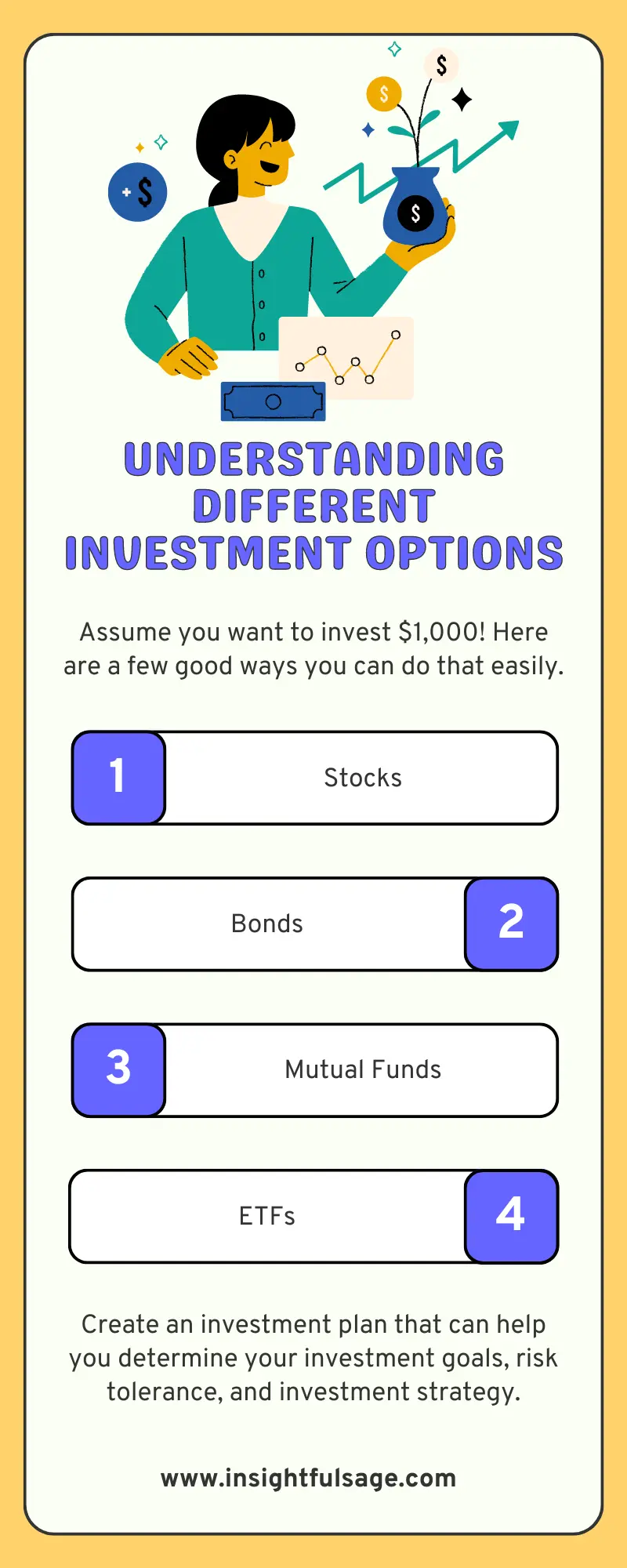Investing your first $1000 can be an exciting yet daunting experience. It’s natural to feel overwhelmed with the vast range of investment options available and the associated risks and rewards.
However, investing $1000 is an excellent opportunity to start building your wealth and securing a better financial future. In this article, we’ll provide you with a comprehensive beginner’s guide to investing $1000, and we’ll help you make the most out of your money.
Firstly, we’ll explore the various investment options available, such as stocks, bonds, mutual funds, and exchange-traded funds (ETFs). We’ll explain the risks and rewards associated with each investment type, enabling you to make an informed decision that suits your investment goals and risk tolerance.
Secondly, we’ll provide you with some valuable tips on creating an investment plan. An investment plan is a crucial element in building a successful investment portfolio. We’ll outline the essential steps involved in creating an investment plan, such as setting your goals, determining your risk tolerance, and selecting the appropriate investment portfolio.
Lastly, we’ll delve into investing your $1000. We’ll explore the different ways to invest, such as investing in individual stocks or mutual funds, and explain how to diversify your investment portfolio. We’ll also provide you with some tips on how to monitor your investments and make any necessary adjustments.
Investing $1000 is an excellent opportunity to start your investment journey and build wealth for your future. This article will equip you with the knowledge and tools required to make informed investment decisions and make the most out of your money.

Understanding The Different Investment Options
Investing your $1000 can be a daunting task, especially if you’re unfamiliar with the various investment options available. In this section, we’ll provide an overview of the different investment options, including stocks, bonds, mutual funds, and exchange-traded funds (ETFs).
Stocks are a type of investment that represents ownership in a company. They are considered high-risk investments but offer the potential for high returns. Bonds, on the other hand, are debt securities issued by governments or corporations. Bonds offer lower returns but are considered less risky than stocks.
Mutual funds are a type of investment that pools money from different investors to purchase a diversified portfolio of stocks, bonds, or other assets. They are considered less risky than individual stocks and provide a diversified investment portfolio. ETFs, similar to mutual funds, track an index or group of assets, but trade like a stock on an exchange.
Each investment type has its own risks and rewards, and understanding how they fit into a long-term investment strategy is crucial. Stocks and mutual funds may be suitable for investors seeking higher returns and willing to accept higher risks, while bonds and ETFs are better suited for investors seeking stability and lower risks.
Understanding the different investment options and their associated risks and rewards is an important step in creating a successful investment portfolio. By exploring each investment type’s features, you can determine which investments best align with your investment goals and risk tolerance.
Creating an Investment Plan
Creating an investment plan is an essential step in building a successful investment portfolio. It helps you determine your investment goals, risk tolerance, and investment strategy. In this section, we’ll discuss the importance of creating an investment plan and provide some tips on how to create a plan that works for you.
The first step in creating an investment plan is setting your investment goals. This includes determining how much money you want to invest, when you want to achieve your investment goals, and what kind of returns you’re looking for.
The next step is determining your risk tolerance. This involves understanding your willingness to accept risk in pursuit of higher returns. This is an important factor as it helps you determine the appropriate investment portfolio for your investment goals and risk tolerance.
Once you have set your goals and determined your risk tolerance, the next step is selecting an investment portfolio. This includes determining the asset allocation between stocks, bonds, and other investments. Diversification is key to a successful investment portfolio and can help balance risk and reward.
Balancing risk and reward is important in any investment portfolio. While higher risk investments may offer the potential for higher returns, they also come with a greater chance of loss. Lower risk investments may offer more stability, but may not provide the same level of returns.
Creating an investment plan is a crucial step in building a successful investment portfolio. By setting your investment goals, determining your risk tolerance, and selecting an appropriate investment portfolio, you can balance risk and reward and build a portfolio that aligns with your investment goals and risk tolerance.
Investing Your $1000
Investing your $1000 wisely is essential to achieving your investment goals. In this section, we’ll discuss the different ways to invest your $1000, how to diversify your investments, and the importance of monitoring your investments.
One option for investing your $1000 is to invest in individual stocks. This allows you to own a share of a particular company and potentially earn returns from its growth. However, investing in individual stocks can be risky and requires a lot of research to make informed decisions.
Another option is to invest in mutual funds. This allows you to pool your money with other investors to create a diversified portfolio of stocks, bonds, or other investments. This can be a great option for investors who want to spread their risk across different investments and have professional management of their portfolio.
Diversifying your investments is crucial to reducing risk and maximizing returns. This can be achieved by investing in a mix of different types of assets, such as stocks, bonds, and ETFs. It’s important to choose investments with different risk profiles and to avoid overconcentration in any single asset.
Finally, monitoring your investments and making adjustments as needed is essential to achieving your investment goals. This means regularly reviewing your portfolio’s performance and adjusting your investment strategy if needed. For example, you may want to rebalance your portfolio periodically to maintain your desired asset allocation.
Investing your $1000 requires careful consideration and planning. By diversifying your investments, monitoring your portfolio’s performance, and making adjustments as needed, you can build a successful investment portfolio that aligns with your investment goals and risk tolerance.
Tips For Successful Investing
Investing can be challenging, but there are certain tips that can help you achieve success. In this section, we’ll discuss some key tips for successful investing, such as investing for the long-term, avoiding emotional decisions, and staying disciplined.
The first tip for successful investing is to invest for the long-term. This means focusing on your investment goals and staying invested even during market downturns. Historically, the stock market has provided strong returns over the long-term, but short-term fluctuations can be unpredictable.
Another important tip is to avoid making emotional decisions. It’s easy to get caught up in market volatility and make impulsive decisions based on fear or greed. However, this can lead to costly mistakes and prevent you from achieving your investment goals. Staying disciplined and sticking to your investment plan can help you avoid these emotional traps.
Staying disciplined also means avoiding the temptation to time the market. Trying to predict short-term market movements is extremely difficult, and even the most seasoned investors can get it wrong. Instead, focus on building a diversified portfolio that aligns with your investment goals and risk tolerance.
Finally, consider seeking professional advice. A financial advisor can provide valuable guidance on building a successful investment portfolio and help you navigate complex investment decisions.
Successful investing requires discipline, patience, and a long-term perspective. By investing for the long-term, avoiding emotional decisions, and staying disciplined, you can achieve your investment goals and build a portfolio that aligns with your risk tolerance and financial objectives.
Conclusion
Investing $1000 can be a great way to kickstart your journey towards building wealth and securing your financial future. Throughout this article, we have discussed the different investment options available, the importance of creating an investment plan, and some key tips for successful investing.
It’s important to understand that investing is a long-term process that requires careful consideration and planning. By taking the time to research different investment options, setting clear investment goals, and creating a well-diversified investment portfolio, you can maximize your returns and reduce your risk.
Additionally, staying disciplined and avoiding emotional decisions is crucial to achieving your investment goals. The stock market can be unpredictable, and it’s easy to get caught up in short-term fluctuations. By focusing on the long-term and sticking to your investment plan, you can avoid costly mistakes and stay on track towards achieving your investment goals.
Investing $1000 may seem daunting at first, but with the right approach and mindset, you can make the most out of your money and build a successful investment portfolio. Remember to stay disciplined, diversify your investments, and focus on your long-term investment goals, and you’ll be well on your way towards building a more secure financial future.





